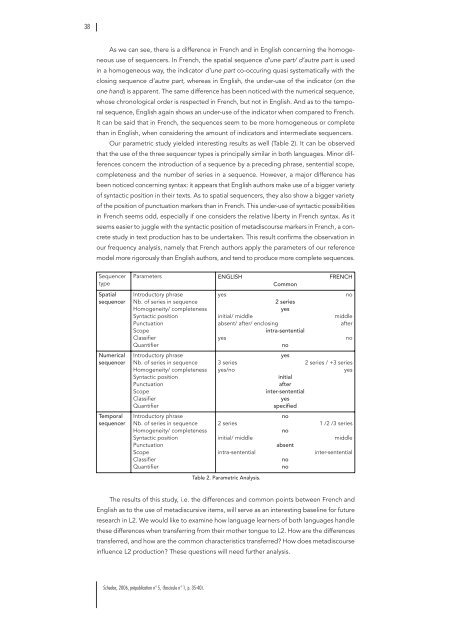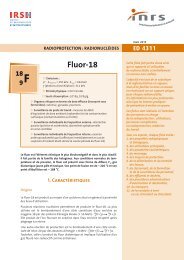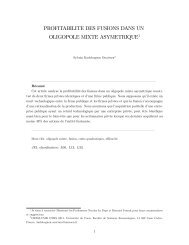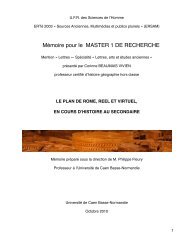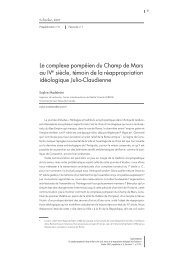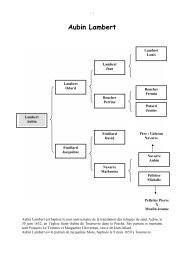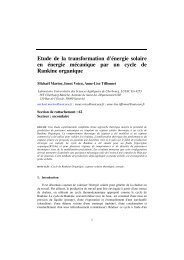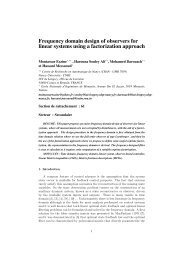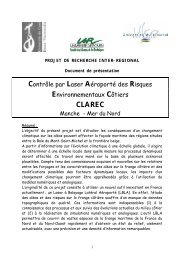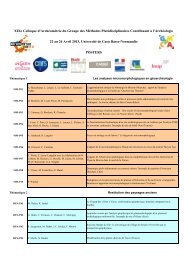The use of sequencers in academic writing - Université de Caen ...
The use of sequencers in academic writing - Université de Caen ...
The use of sequencers in academic writing - Université de Caen ...
You also want an ePaper? Increase the reach of your titles
YUMPU automatically turns print PDFs into web optimized ePapers that Google loves.
38<br />
As we can see, there is a difference <strong>in</strong> French and <strong>in</strong> English concern<strong>in</strong>g the homogeneous<br />
<strong>use</strong> <strong>of</strong> <strong>sequencers</strong>. In French, the spatial sequence d’une part/ d’autre part is <strong>use</strong>d<br />
<strong>in</strong> a homogeneous way, the <strong>in</strong>dicator d’une part co-occur<strong>in</strong>g quasi systematically with the<br />
clos<strong>in</strong>g sequence d’autre part, whereas <strong>in</strong> English, the un<strong>de</strong>r-<strong>use</strong> <strong>of</strong> the <strong>in</strong>dicator (on the<br />
one hand) is apparent. <strong>The</strong> same difference has been noticed with the numerical sequence,<br />
whose chronological or<strong>de</strong>r is respected <strong>in</strong> French, but not <strong>in</strong> English. And as to the temporal<br />
sequence, English aga<strong>in</strong> shows an un<strong>de</strong>r-<strong>use</strong> <strong>of</strong> the <strong>in</strong>dicator when compared to French.<br />
It can be said that <strong>in</strong> French, the sequences seem to be more homogeneous or complete<br />
than <strong>in</strong> English, when consi<strong>de</strong>r<strong>in</strong>g the amount <strong>of</strong> <strong>in</strong>dicators and <strong>in</strong>termediate <strong>sequencers</strong>.<br />
Our parametric study yiel<strong>de</strong>d <strong>in</strong>terest<strong>in</strong>g results as well (Table 2). It can be observed<br />
that the <strong>use</strong> <strong>of</strong> the three sequencer types is pr<strong>in</strong>cipally similar <strong>in</strong> both languages. M<strong>in</strong>or differences<br />
concern the <strong>in</strong>troduction <strong>of</strong> a sequence by a preced<strong>in</strong>g phrase, sentential scope,<br />
completeness and the number <strong>of</strong> series <strong>in</strong> a sequence. However, a major difference has<br />
been noticed concern<strong>in</strong>g syntax: it appears that English authors make <strong>use</strong> <strong>of</strong> a bigger variety<br />
<strong>of</strong> syntactic position <strong>in</strong> their texts. As to spatial <strong>sequencers</strong>, they also show a bigger variety<br />
<strong>of</strong> the position <strong>of</strong> punctuation markers than <strong>in</strong> French. This un<strong>de</strong>r-<strong>use</strong> <strong>of</strong> syntactic possibilities<br />
<strong>in</strong> French seems odd, especially if one consi<strong>de</strong>rs the relative liberty <strong>in</strong> French syntax. As it<br />
seems easier to juggle with the syntactic position <strong>of</strong> metadiscourse markers <strong>in</strong> French, a concrete<br />
study <strong>in</strong> text production has to be un<strong>de</strong>rtaken. This result confirms the observation <strong>in</strong><br />
our frequency analysis, namely that French authors apply the parameters <strong>of</strong> our reference<br />
mo<strong>de</strong>l more rigorously than English authors, and tend to produce more complete sequences.<br />
Sequencer<br />
type<br />
Spatial<br />
sequencer<br />
Numerical<br />
sequencer<br />
Temporal<br />
sequencer<br />
Parameters ENGLISH FRENCH<br />
Common<br />
Introductory phrase<br />
Nb. <strong>of</strong> series <strong>in</strong> sequence<br />
Homogeneity/ completeness<br />
Syntactic position<br />
Punctuation<br />
Scope<br />
Classifier<br />
Quantifier<br />
Introductory phrase<br />
Nb. <strong>of</strong> series <strong>in</strong> sequence<br />
Homogeneity/ completeness<br />
Syntactic position<br />
Punctuation<br />
Scope<br />
Classifier<br />
Quantifier<br />
Introductory phrase<br />
Nb. <strong>of</strong> series <strong>in</strong> sequence<br />
Homogeneity/ completeness<br />
Syntactic position<br />
Punctuation<br />
Scope<br />
Classifier<br />
Quantifier<br />
yes<br />
no<br />
2 series<br />
yes<br />
<strong>in</strong>itial/ middle<br />
middle<br />
absent/ after/ enclos<strong>in</strong>g<br />
after<br />
<strong>in</strong>tra-sentential<br />
yes<br />
no<br />
no<br />
yes<br />
3 series 2 series / +3 series<br />
yes/no<br />
yes<br />
<strong>in</strong>itial<br />
after<br />
<strong>in</strong>ter-sentential<br />
yes<br />
specified<br />
no<br />
2 series 1 /2 /3 series<br />
no<br />
<strong>in</strong>itial/ middle<br />
middle<br />
absent<br />
<strong>in</strong>tra-sentential<br />
<strong>in</strong>ter-sentential<br />
no<br />
no<br />
Table 2. Parametric Analysis.<br />
<strong>The</strong> results <strong>of</strong> this study, i.e. the differences and common po<strong>in</strong>ts between French and<br />
English as to the <strong>use</strong> <strong>of</strong> metadiscursive items, will serve as an <strong>in</strong>terest<strong>in</strong>g basel<strong>in</strong>e for future<br />
research <strong>in</strong> L2. We would like to exam<strong>in</strong>e how language learners <strong>of</strong> both languages handle<br />
these differences when transferr<strong>in</strong>g from their mother tongue to L2. How are the differences<br />
transferred, and how are the common characteristics transferred? How does metadiscourse<br />
<strong>in</strong>fluence L2 production? <strong>The</strong>se questions will need further analysis.<br />
Schedae, 2006, prépublication n°5, (fascicule n°1, p. 35-40).


